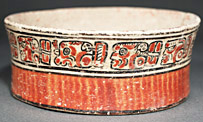Hieroglyphs on Pottery
 |
| Example of a hieroglyph from a previously unpublished Primary Stanard Sequence from a Late Classic bowl, Peten, Guatemala. |
Mayan hieroglyphs on pottery are a main goal of the research of the F.L.A.A.R. Photo Archive. We have photographed several hundred complete Primary Standard Sequences (PSS). Each individual glyph is photographed at 1:1 scale with a Leica. If the glyphs are larger than 35mm format (such as glyphs on the sidewalls of some plates) then we photograph them with a Hasselblad. Indeed each individual glyph is photographed twice, once with black-and-white film and then again a second time with color film.
In 1996 we began to do rollout photographs of hieroglyphs on Maya vases and bowls. One of the three rollout cameras that we now have can also do rollouts of the inside sidewall of plates and wide bowls. Since most plates have their PSS on the inside sidewall, this new camera opens up the possibility to get a more accurate record of these inscriptions.
| Hieroglyphs on mayan vase |
But not all hieroglyphs are the Primary Standard Sequence. Hundreds of horizontal text bands exist which are repeats, one or more glyphs repeated around the circumference of the pot. Such glyphs were dismissed by Thompson as unworthy "decorations." But now it is possible to use repeats to ascertain who painted or incised the inscription. This information will assist in figuring out which regional workshop produced the text.
The rollout here shows a partial rim band text from the Middle Motagua Valley area. The Museo Popol Vuh has several vases of this style. By doing rollouts of all extant Motagua vases it will be possible to estimate how many scribes were at work. It is interesting to work out the scribes of this part of Zacapa because Motagua style pots share many traits with pottery of nearby Copan (which is less than 80 miles away, albeit over the mountains). Many of the vases in the two richest tombs of Tikal were of a Peten style which shared many features with the Motagua style, a fact that was not noted in the monograph on the Tikal ceramic sequence (and probably not in Coggin's Ph.D., dissertation on Tikal ceramics, either, though that is not available to check at the moment). Both the reports on the Tikal ceramic sequence avoid references to material in museums or private collections. Since those sources are where most of the information is, it is no wonder those reports miss the key data.
 |
| Maya vase rollout |
New page format posted July 9, 2009